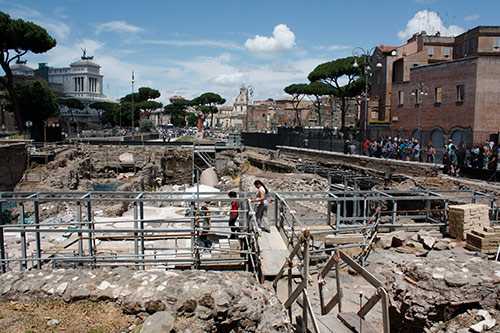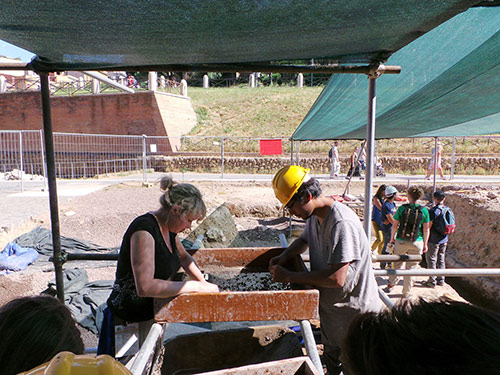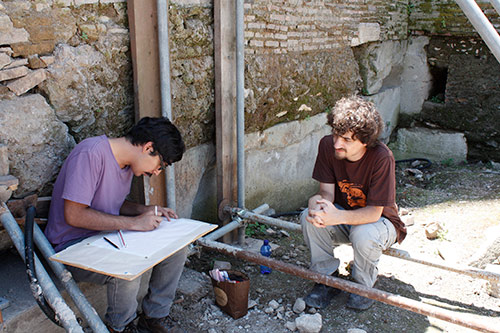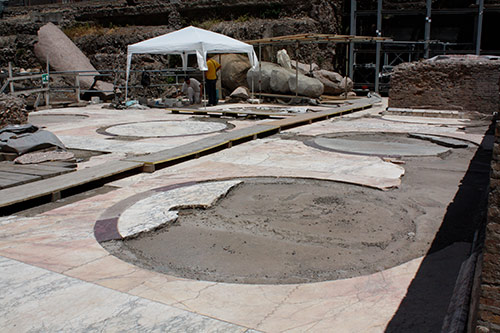Italy’s most iconic monuments have no end of surprises, as AUR students learned during summer excavations at the Colosseum and Imperial Fora. They also got to practice their Italian and exchange cultures working alongside archaeologists from Rome’s second-largest university, Roma Tre.
With one of Italy’s most prestigious archaeology departments, Roma Tre is the only university in the world to have a collaboration with the state Ministry of Cultural Heritage to dig at the nearly 2,000-year-old ruins and, thanks to connections between faculty, AUR is the only other university to join them. This year marked the fourth summer the two universities have joined forces for the Archaeology Practicum. “I think it’s amazing that we get to work on some of these sites,” said student Megan Reaser, a junior in AUR’s B.A. in Archaeology & Classics program.
Of the 150 applicants for the class, only 15 from Roma Tre and five from AUR were chosen, said Dr. Giulia Facchin, Professor of Archaeology at AUR. The excavations, begun by Roma Tre in 2011, have made important contributions to understanding the Colosseum’s life after the games ended, at the decline of the Roman Empire.

The archaeological project spans from 7th-12th Century AD, the High Medieval to Central Middle Ages, when the disused and sacked Colosseum and Fora buildings were taken over by peasants for shelter, workshops, animal barns, and storage units. “This project has many objectives: research, preservation, management and development of the site, as well as teaching young archaeologists and future site managers,” said Facchin, who taught and supervised the student crews. “It’s a fantastic opportunity for AUR students to enter into a real Italian culture, to mix and share.”
The one-month course is open to all full-time AUR undergraduates and Master’s students, regardless of major. Students have a week of training in class, then hit the dirt (literally) putting in 40-hour weeks from Monday to Friday, earning three credits. The practicum also meets the General Education requirement of Alternative Educational Experience.
The students found some tasks to be physically draining – due to the 90F (32C) heat of June -- and others tedious (sifting dirt for hours without finding anything), but it was all worth it to have the privilege to say, “I dug at the Colosseum.”
“Most of the (Italian) supervisors are closer to my age (25 years old) than I would have expected and that makes for an interesting dynamic,” said Joe Pecora, a Master’s student in Sustainable Cultural Heritage. “I thought they would be older (age 50-60) or they would be present on site but not so much participating in the physical aspects of it. Instead, they were able to get down in the dirt with us. I’m pleased about that.”

The excitement of Colosseum sewers, and other discoveries
The first days were a bit rough, said AUR junior Lydia Bosch, an Archaeology & Classics major with a minor in Film & Digital Media. It was her first Roman summer working outside all day and she found the heat oppressive, especially when she had to wear a hard hat and face mask. Her Italian also got a workout. “I felt intimidated, struggling with Italian, but then it started to get easier,” said Bosch. “I didn’t expect to enjoy it as much as I did. We had thunderstorms, and after it would get super humid. You learn to take care of yourself, drink lots of water and stay in the shade.” A light rain sometimes helped, however, since it made the colors of the sand more intense and easier to identify different layers and time periods.
Learning not to judge their findings was key, as they washed and sorted bits of ceramic, marble pieces and animal bones (mostly of pigs, sheep, and goats). Hundreds of artifacts ended up in plastic cases stacked high along the perimeters, all for later inspection and identification. “I don’t search for objects. I search for humans,” said Facchin. “This is a question of being a historian. If you judge, you can misrepresent. First, we record the items and interpretation comes later.”
One of the highlights was finding ancient dice, coins and gaming pieces near an external ring of the Colosseum and discovering a sewer trough. “It actually was!” said Reaser. “It sounds ridiculous and I wasn’t thrilled when I heard what it was. But we actually got down to the start of the sewer. It was really nice because we found it the day before the dig ended. We thought we weren’t going to be able to get down to the Imperial period, so it was exciting to do that.”
However, the discovery of more than 200 bronze coins (equal to today’s pennies) along with dozens of dice from the 5th-Century AD attracted more media coverage than the sewer. Local newspapers painted a scenario of Romans betting on the fights (mostly bears vs hunters) and throwing dice while waiting for the next match. The bears came from the local mountains; gladiators, tigers and other exotic animals were too expensive and had long gone by the 400s. The Empire was in economic decline, but people could still afford to lose a few pennies.
Experiencing life as an archaeologist
“I think most people assume you’re just going out and digging,” said Pecora. “But there’s a whole technical process behind that. You have to be very meticulous in the preparation, getting all your materials set and making sure that you have properly sketched the area and have made note of the environment before disturbing it. You only have one chance to look at a context. Once it’s gone, it’s gone forever and you can’t remake it. That’s probably the most important thing.”
About three blocks away from the Colosseum, another team of students was working in the Temple of Peace, also known as the Forum of Vespasian. They concentrated on cleaning and mapping a newly discovered stone wall, part of the Temple’s garden, and a segment of a Medieval road set in place some 300 years before Christ. In an area off-limits to the public, AUR Archaeology & Classics student, Derek Cebrian, sat in the shade of the wall with a sketchbook on his knees, pencil and ruler in hand. He listened as his colleague called out measurements of the height and depth of rock fragments jutting out from the wall’s surface. Cebrian repeated the numbers, plotting them on grid paper. Slowly, a miniature version of the wall’s nooks and crannies emerged on paper. It took them about a day to plot a poster-size segment. “Sometimes, you can get more information from a sketch than you can from a photo,” Cebrian said.

In addition to sketching and photographing, students also learned to use surveying equipment and AutoCAD (computer-aided design) to build a digitalized 3-D image of the area.
Built in 75 AD, the Temple featured a statue of the Goddess Peace and apparently held the sacred relics of the Temple of Jerusalem, destroyed by the Romans in their conquest of the Holy Land in 70 AD. But after centuries of earthquakes, fires, rebuilding, and sacking by barbarians, not much of the original Roman temple remains, except its beautiful multi-colored marble floor, dating from 205-206 AD from Emperor Septimius Severus. “Still pretty ancient,” joked Facchin, who pointed out its large circular inlays of purple-red porphyry, a stone symbolizing prestige and majesty. “It was an immense discovery and totally unexpected because normally the marble floors were removed to be reused in churches and private houses,” she added. What saved this floor was a mere 4 inches (10 cm) of dirt and a housing development. Facchin explained that already by the year 1,000, the public had long forgotten about the square and it was covered by centuries of earth. The Romans salvaged the area’s Travertine blocks for other buildings, but they didn’t know what was underneath. In addition, in the 1500s, people started building houses over the site, which saved it from being discovered by antiquity hunters or looters. The house foundations stopped just inches above the marble floor. “They destroyed some parts of the pedestal, but we were really fortunate. It’s just fortune,” said Facchin.

Restoring history to the public
Uncovering history is only one part of an archaeologist’s job; returning it to the public is the other.
“We stop over here,” said Facchin, pointing to where their Medieval road met the sidewalk of Via dei Foro Imperiali. “Soon, this will become a clear path where people can walk to visit the entire site.” The road, more like a footpath, was used for centuries to connect the Forum -- the ancient city center -- to the Esquiline hill. The blocks of basalt may even date from the time of the emperors or before since materials were often recycled, noted Facchin. She pointed across Via dei Fori Imperiali, where the route of the footpath continues today, now as a street running next to the Tourist Information Center and under an archway towards Termini train station. On the sidewalk above, tourists peered through the wire fence and stopped to take photos of the students working in the pit, about five feet below street level.
“My background is not even history or archaeology," said student Dustin Caravaglia, who came into the Sustainable Cultural Heritage master’s with a degree in biology. “But the fact that I got to work on an archaeological dig will enable me to have an idea of what they are doing and work cohesively with them in the future.”
Valerie Higgins, AUR’s Associate Professor of Archaeology and Program Director of the Master’s in Sustainable Cultural Heritage added, “Giulia and her team do a fantastic job every summer on a very technically demanding dig. Through these excavations they, and Professor Riccardo Santangeli Valenzani, the scientific director, have transformed our ideas of life in medieval Rome. It is such a privilege for our students to be able to take part alongside the Rome Tre students.”
